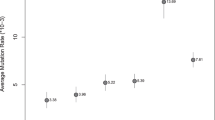Abstract
A deviation from the stepwise mutation model (SMM) has been suggested for the trinucleotide Y-STR locus DYS392, based upon its bimodal allele frequency distribution in various populations. The same type of distribution is also observed for the pentanucleotide Y-STR DYS438. In order to verify whether a departure from an SMM is likely for these two loci, we studied a large number of Portuguese male DNA samples typed for the two loci and in addition, for the Y-STR loci DYS19, DYS389I/II, DYS390, DYS391 and DYS393. The compatibility of the observed allele frequency spectrum with an SMM was assessed by an apportionment of the molecular variance among, and consideration of the molecular distances between, haplotype groups defined according to their allelic state at each of the two markers of interest. For haplotypes carrying either modal alleles 11 or 13 of DYS392, 18.6% of the molecular variance of the remaining Y-STR background could be attributed to variation between the two groups. When all pairwise Φst values between haplotype groups were compared, group 12 was found to be closer to 11 than to 13, and group 14 was much closer to 13 than to 12 and 11. It may therefore be concluded that DYS392 allele 13 represents an evolutionary lineage with little or no relationship to 11 and 12. Furthermore, allele 14 is a one-step neighbour of 13 and is therefore likely to represent an offshoot from group 13. For haplotypes carrying either modal allele 10 or modal allele 12 of DYS438, 27.7% of the molecular variance of the Y-STR background was found to be due to variation between the two groups. Comparison of the other pairwise Φst values indicated that group 10 was closer to 9 and 11 than to 12, and that group 12 was closer to 11 and 13 than to 10. The lineages defined by the two modal alleles of DYS438 therefore also seem to be phylogenetically distant. When the two loci were analysed in combination, using the standardised linkage disequilibrium measure (D'), a strong association was noted between alleles DYS392*11 and DYS438*10 (D'=0.70) and between DYS392*13 and DYS438*12 (D'=0.72). Taken together, these results show that the bimodal allele frequency distributions of DYS392 and DYS438 are explicable in terms of (probably the same) historical and demographic causes, rather than a mutational mechanism other than SMM. The loci do therefore not appear to warrant any special attention when applied in population genetic or forensic studies.
Similar content being viewed by others
References
Forster P, Rohl A, Lunnemann P, Brinkmann C, Zerjal T, Tyler-Smith C, Brinkmann B. (2000) A short tandem repeat-based phylogeny for the human Y chromosome. Am J Hum Genet 67:182–196
Gusmão L, Alves C, Amorim A (2001) Molecular characterisation of four Y-specific microsatellites (DYS434, DYS437, DYS438, DYS439) for population and forensic studies. Ann Hum Genet 65:285–291
Gusmão L, Alves C, Beleza S, Amorim A (2002) Forensic evaluation and population data on the new Y-STRs DYS434, DYS437, DYS438, DYS439 and GATA A10. Int J Legal Med 116:139–147
Heyer E, Puymirat J, Dieltjes P, Bakker E, Knijff P de (1997) Estimating Y chromosome specific microsatellite mutation frequencies using deep rooting pedigrees. Hum Mol Genet 6:799–803
Holtkemper U, Rolf B, Hohoff C, Forster P, Brinkmann B (2001) Mutation rates at two human Y-chromosomal microsatellite loci using small pool PCR techniques. Hum Mol Genet 10:629–633
Kayser M, Sajantila A (2001) Mutation at Y-STR loci: implications for paternity testing and forensic analysis. Forensic Sci Int 118:116–121
Kayser M, Roewer L, Hedman M et al. (2000) Characteristics and frequency of germline mutations at microsatellite loci from the human Y chromosome, as revealed by direct observation in father/son pairs. Am J Hum Genet 66:1580–1588
Kayser M, Krawczak M, Excoffier L et al. (2001) An extensive analysis of Y-chromosomal microsatellite haplotypes in globally dispersed human populations. Am J Hum Genet 68:990–1018
Knijff P de (2000) Messages through bottlenecks: on the combined use of slow and fast evolving polymorphic markers on the human Y chromosome. Am J Hum Genet 67:1055–1061
Nebel A, Filon D, Hohoff C, Faerman M, Brinkmann B, Oppenheim A (2001) Haplogroup-specific deviation from the stepwise mutation model at the microsatellite loci DYS388 and DYS392. Eur J Hum Genet 9:22–26
Roewer L, Krawczak M, Willuweit S et al. (2001) Online reference database of European Y-chromosomal short tandem repeat (STR) haplotypes. Forensic Sci Int 118:106–113
Schneider S, Roessli D, Excoffier L (2000) Arlequin ver. 2.000. A software for population genetics data analysis. University of Geneva
Thomas MG, Parfitt T, Weiss DA, Skorecki K, Wilson JF, Roux M le, Bradman N, Goldstein DB (2000) Y Chromosomes travelling south: the Cohen modal haplotype and the origins of the Lemba—the "Black Jews of Southern Africa". Am J Hum Genet 66:674–686
Uchihi R, Yamamoto T, Usuda K et al. (2003) Haplotype analysis with 14 Y-STR loci using 2 multiplex amplification and typing systems in 2 regional populations in Japan. Int J Legal Med 117:34–38
Weale ME, Yepiskoposyan L, Jager RF, Hovhannisyan N, Khudoyan A, Burbage-Hall O, Bradman N, Thomas MG (2001) Armenian Y chromosome haplotypes reveal strong regional structure within a single ethno-national group. Hum Genet 109:659–674
Acknowledgements
This work was partially supported by Fundação para a Ciência e a Tecnologia (through grants SFRH/BD/860/2000 and SFRH/BD/7006/2001, and POCTI, Programa Operacional Ciência, Tecnologia e Inovação).
Author information
Authors and Affiliations
Corresponding author
Rights and permissions
About this article
Cite this article
Gusmão, L., Krawczak, M., Sánchez-Diz, P. et al. Bimodal allele frequency distribution at Y-STR loci DYS392 and DYS438: no evidence for a deviation from the stepwise mutation model. Int J Legal Med 117, 287–290 (2003). https://doi.org/10.1007/s00414-003-0388-1
Received:
Accepted:
Published:
Issue Date:
DOI: https://doi.org/10.1007/s00414-003-0388-1




